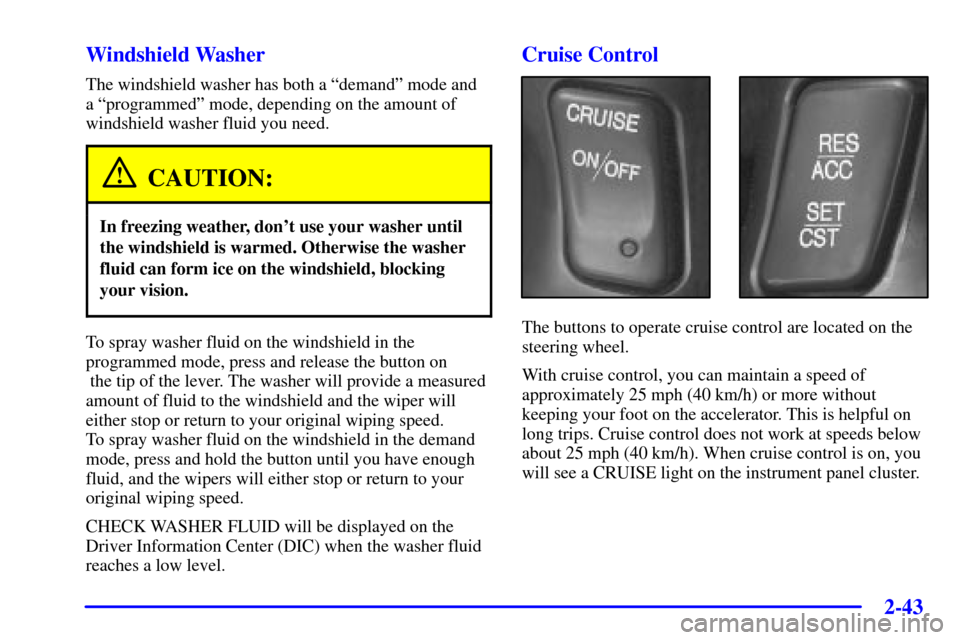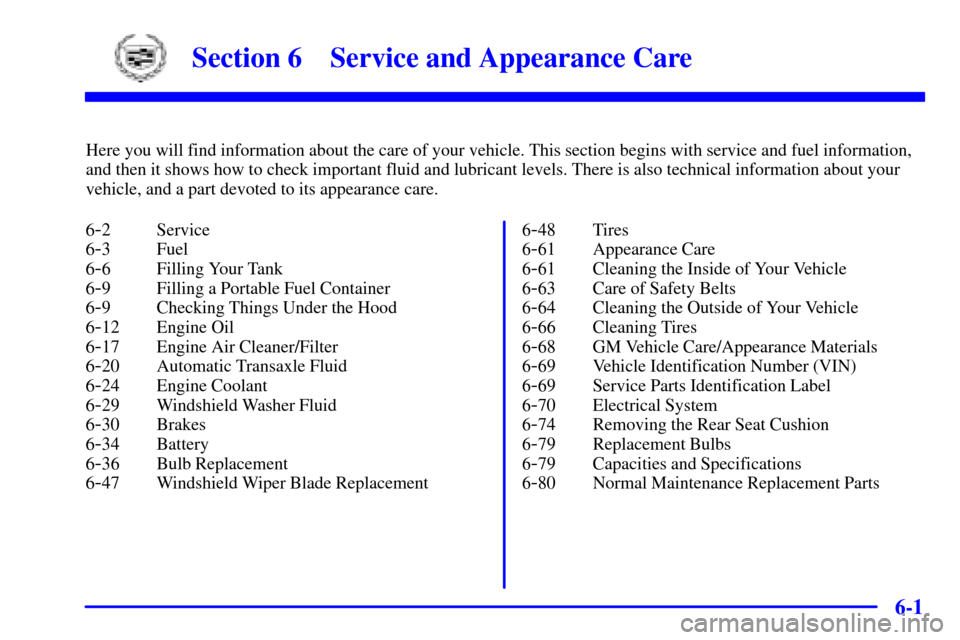Page 100 of 399

2-43 Windshield Washer
The windshield washer has both a ªdemandº mode and
a ªprogrammedº mode, depending on the amount of
windshield washer fluid you need.
CAUTION:
In freezing weather, don't use your washer until
the windshield is warmed. Otherwise the washer
fluid can form ice on the windshield, blocking
your vision.
To spray washer fluid on the windshield in the
programmed mode, press and release the button on
the tip of the lever. The washer will provide a measured
amount of fluid to the windshield and the wiper will
either stop or return to your original wiping speed.
To spray washer fluid on the windshield in the demand
mode, press and hold the button until you have enough
fluid, and the wipers will either stop or return to your
original wiping speed.
CHECK WASHER FLUID will be displayed on the
Driver Information Center (DIC) when the washer fluid
reaches a low level.
Cruise Control
The buttons to operate cruise control are located on the
steering wheel.
With cruise control, you can maintain a speed of
approximately 25 mph (40 km/h) or more without
keeping your foot on the accelerator. This is helpful on
long trips. Cruise control does not work at speeds below
about 25 mph (40 km/h). When cruise control is on, you
will see a CRUISE light on the instrument panel cluster.
Page 151 of 399

2-94
CHECK WASHER FLUID - 25: This message means
that your vehicle is low on windshield washer fluid.
DRIVER DOOR AJAR
- 140: This message will
display anytime the key is in ON, the transaxle is not
in PARK (P) and the driver's door is open or ajar.
A chime will sound when the vehicle's speed is greater
than 3 mph (4.8 km/h).
DRIVER NO. X (1 OR 2): This message will be
displayed with the key in ON and while entering
FEATURE PROGRAMMING, but only if the vehicle
is equipped with memory seats. The message will show
which driver is activating the personalization feature.
It will only stay on for five seconds. This message can
be customized for you by your dealer.
ENGINE COOLANT HOT, IDLE ENGINE
- 44:
This message will appear when the engine coolant
temperature is over 262�F (128�C). Stop and allow
your vehicle to idle in PARK (P) until it cools down and
the message is removed. Do not increase engine speed
above a normal idle. If it does not cool down, turn off
the engine and have it serviced before driving it again.
Severe engine damage can result from an overheated
engine. See ªEngine Overheatingº in the Index.ENGINE HOT
-AC OFF - 16: This message displays
when the engine coolant becomes hotter than the normal
operating temperature. To avoid added strain on a hot
engine, the air conditioning compressor is automatically
turned off. When the coolant temperature returns to
normal, the A/C operation will automatically resume.
You can continue to drive your vehicle. If this message
continues to appear, have the system repaired as soon as
possible to avoid compressor damage.
ENGINE OVERHEATED, STOP ENGINE
- 42:
This message will appear when the engine has
overheated. Stop and turn the engine off immediately to
avoid severe engine damage. See ªEngine Overheatingº
in the Index. A multiple chime will also sound when this
message is displayed.
ENGINE POWER REDUCED
- 41: This message
informs you that the vehicle is reducing engine power
because the transaxle is being placed in gear under
conditions that may cause damage to the vehicle's
engine, transaxle or ability to accelerate.
FUEL LEVEL LOW
- 11 : This message serves as
a warning that the fuel level in the tank is critically low.
Stop for fuel soon. A single chime will sound when this
message is displayed.
Page 226 of 399

4-18
Driving in Rain and on Wet RoadsRain and wet roads can mean driving trouble. On a wet
road, you can't stop, accelerate or turn as well because
your tire
-to-road traction isn't as good as on dry roads.
And, if your tires don't have much tread left, you'll get
even less traction. It's always wise to go slower and be
cautious if rain starts to fall while you are driving. The
surface may get wet suddenly when your reflexes are
tuned for driving on dry pavement.
The heavier the rain, the harder it is to see. Even if your
windshield wiper blades are in good shape, a heavy rain
can make it harder to see road signs and traffic signals,
pavement markings, the edge of the road and even
people walking.
It's wise to keep your windshield wiping equipment in
good shape and keep your windshield washer tank filled
with washer fluid. Replace your windshield wiper
inserts when they show signs of streaking or missing
areas on the windshield, or when strips of rubber start to
separate from the inserts.
Page 231 of 399

4-23
The exit ramp can be curved, sometimes quite sharply.
The exit speed is usually posted.
Reduce your speed according to your speedometer, not
to your sense of motion. After driving for any distance
at higher speeds, you may tend to think you are going
slower than you actually are.
Before Leaving on a Long Trip
Make sure you're ready. Try to be well rested. If you
must start when you're not fresh
-- such as after a day's
work
-- don't plan to make too many miles that first part
of the journey. Wear comfortable clothing and shoes you
can easily drive in.
Is your vehicle ready for a long trip? If you keep it
serviced and maintained, it's ready to go. If it needs
service, have it done before starting out. Of course,
you'll find experienced and able service experts in
Cadillac dealerships all across North America.
They'll be ready and willing to help if you need it.Here are some things you can check before a trip:
�Windshield Washer Fluid: Is the reservoir full?
Are all windows clean inside and outside?
�Wiper Blades: Are they in good shape?
�Fuel, Engine Oil, Other Fluids: Have you checked
all levels?
�Lamps: Are they all working? Are the lenses clean?
�Tires: They are vitally important to a safe,
trouble-free trip. Is the tread good enough for
long
-distance driving? Are the tires all inflated to the
recommended pressure?
�Weather Forecasts: What's the weather outlook
along your route? Should you delay your trip a short
time to avoid a major storm system?
�Maps: Do you have up
-to-date maps?
Page 234 of 399
4-26
Winter Driving
Here are some tips for winter driving:
�Have your vehicle in good shape for winter.
�You may want to put winter emergency supplies in
your trunk.
Include an ice scraper, a small brush or broom, a supply
of windshield washer fluid, a rag, some winter outer
clothing, a small shovel, a flashlight, a red cloth and a
couple of reflective warning triangles. And, if you will
be driving under severe conditions, include a small bag
of sand, a piece of old carpet or a couple of burlap bags
to help provide traction. Be sure you properly secure
these items in your vehicle.
Page 282 of 399

6-
6-1
Section 6 Service and Appearance Care
Here you will find information about the care of your vehicle. This section begins with service and fuel information,
and then it shows how to check important fluid and lubricant levels. There is also technical information about your
vehicle, and a part devoted to its appearance care.
6
-2 Service
6
-3 Fuel
6
-6 Filling Your Tank
6
-9 Filling a Portable Fuel Container
6
-9 Checking Things Under the Hood
6
-12 Engine Oil
6
-17 Engine Air Cleaner/Filter
6
-20 Automatic Transaxle Fluid
6
-24 Engine Coolant
6
-29 Windshield Washer Fluid
6
-30 Brakes
6
-34 Battery
6
-36 Bulb Replacement
6
-47 Windshield Wiper Blade Replacement6
-48 Tires
6
-61 Appearance Care
6
-61 Cleaning the Inside of Your Vehicle
6
-63 Care of Safety Belts
6
-64 Cleaning the Outside of Your Vehicle
6
-66 Cleaning Tires
6
-68 GM Vehicle Care/Appearance Materials
6
-69 Vehicle Identification Number (VIN)
6
-69 Service Parts Identification Label
6
-70 Electrical System
6
-74 Removing the Rear Seat Cushion
6
-79 Replacement Bulbs
6
-79 Capacities and Specifications
6
-80 Normal Maintenance Replacement Parts
Page 290 of 399

6-9
Filling a Portable Fuel Container
CAUTION:
Never fill a portable fuel container while it is in
your vehicle. Static electricity discharge from the
container can ignite the gasoline vapor. You can
be badly burned and your vehicle damaged if this
occurs. To help avoid injury to you and others:
�Dispense gasoline only into
approved containers.
�Do not fill a container while it is inside a
vehicle, in a vehicle's trunk, pickup bed or
on any surface other than the ground.
�Bring the fill nozzle in contact with the
inside of the fill opening before operating
the nozzle. Contact should be maintained
until the filling is complete.
�Don't smoke while pumping gasoline.
Checking Things Under the Hood
CAUTION:
An electric fan under the hood can start up and
injure you even when the engine is not running.
Keep hands, clothing and tools away from any
underhood electric fan.
CAUTION:
Things that burn can get on hot engine parts and
start a fire. These include liquids like gasoline,
oil, coolant, brake fluid, windshield washer and
other fluids, and plastic or rubber. You or others
could be burned. Be careful not to drop or spill
things that will burn onto a hot engine.
Page 292 of 399
6-11 Engine Compartment Overview
When you open the hood, you'll see:
A. Windshield Washer Fluid Reservoir
B. Underhood Fuse Block
C. Power Steering Fluid Reservoir
D. Engine Oil Fill LocationE. Engine Oil Dipstick
F. Brake Master Cylinder Reservoir
G. Transaxle Fluid Cap and DipstickH. Engine Air Cleaner/Filter
I. Engine Coolant Surge Tank and
Pressure Cap